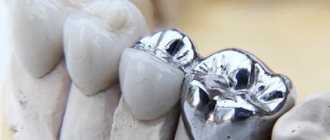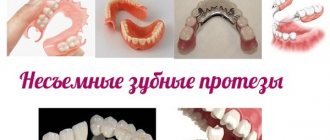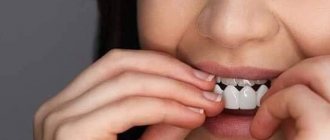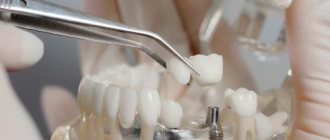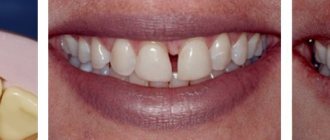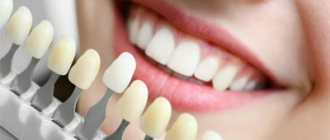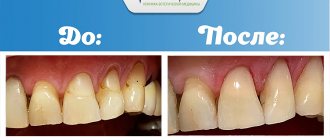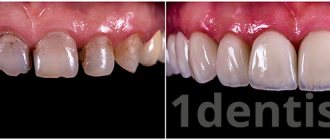Types of ceramic veneers
The classification of veneers is related to their manufacturing technologies.
Pressed veneers are made from dental porcelain. As a result, an ultra-thin plate is created, which is subsequently ground and glazed, which creates a pleasant natural shine. A similar technique is used to create ultra-thin E-max ceramic veneers.
Zirconium veneers are a separate type of ceramic veneers that are made from zirconium dioxide. The basis of the two-layer structure is a zirconium plate. A ceramic layer is applied to it. The zirconium frame provides extra strength.
Other benefits include:
• the shade does not change over time; • thickness of only 0.3 mm ensures invisibility; • does not cause allergies; • service life 20 years.
Not everyone can afford the price. This is the drawback.
A popular service at our clinic is the installation of feldspathic veneers. During their manufacture, the technician applies ceramics layer by layer, which is a precise, highly artistic work. The ceramic layers are no more than a fraction of a millimeter. During the specialist’s work, anthropometric data are taken into account. With their help, it is possible to present the overall picture of the dentition, the smile line, and plan the ideal shape of the structure. As a result, feldspathic veneers cannot be distinguished from natural teeth. .
Lumineers
The perfect (Hollywood) smile can be achieved with lumineers. The design of lumineers is slightly thinner than conventional veneers. The shape is similar to petals. To fix lumineers, veneer adhesive is used.
There are standard and individual lumineers. The former have a variety of colors and sizes. They are somewhat similar in installation to false nails. The latter are made in the laboratory depending on the individual characteristics of the patient.
Lumineers increase the volume of teeth. They are used in cases:
- Slight discoloration of teeth. The design of the devices is very thin (0.3 mm), translucent, so they cannot hide the obvious unevenness of color.
- Small diastemas between teeth. Lumineers cover them well.
- The presence of chips on the teeth and their concealment. Here, individual lumineers will be used, in which the thickness at the chip site should be greater.
- The appearance of cracks in the enamel that you want to hide.
Lumineers have a significant drawback, which manifests itself in a short service life due to low reliability. Broken material unfortunately cannot be repaired. Some procedures will need to be completed first.
A positive aspect of veneering is that the glue on which it is attached contains the element fluorine. Therefore, experts say that wearing such structures is beneficial for tooth enamel.
After installing the veneers, the dentist will invite the patient for a second appointment. This will happen in about a week. The doctor will examine your teeth and gums. He will look at how the teeth have adapted to the installed material. In addition, the doctor can perform the final steps to adjust the veneers. That is, after his manipulations, the mouth will look even better. Now it will be easier for the tooth and veneer to cope with their functions.
Manufacturing and installation
Ceramic veneers are installed after successive stages of work by a doctor at the ROCOSCLINIC clinic.
1. Consultation - a specialist finds out what aesthetic problems concern the client. The bite, defects, and enamel shade are taken into account. 2. The technician performs virtual modeling of teeth using a computer program. With the help of simple manipulations, thanks to mock-up technology, the formed volume of teeth helps to create temporary plastic structures. 3. Fitting, approval of the shape and color of the crown of the teeth. 4. Fixation of permanent ceramic restorations using a microscope ensures high precision.
Products are manufactured in our dental laboratory.
Reliable fixation of veneers
The onlays are fixed using a special strong dental glue, resulting in a monolithic “veneer + tooth” structure. The inner surface of the plates has roughness - for better adhesion to dental tissues. When preparing the enamel, the dentist will also create the necessary microrelief. Then the doctor treats the surfaces of the veneer and tooth with special preparations, applies glue and carefully fixes the veneer. If all the nuances of the technology are followed, there will be no problems with falling out veneers. High-quality micro-prostheses will last from 10 to 15 years or more.
How is a ceramic veneer different from a lumineer?
Ceramic veneers and lumineers are not the same thing. Lumineers are also dental coverings, only:
• veneers are thicker, so you have to grind off the enamel layer before installing them. In addition, at the junction of the gum and the attachment of the plate, after a while a small space may form where food debris will accumulate; • the warranty period for veneers is shorter; • veneers are cheaper than lumineers.
Lumineers have recently appeared. People often call them “Hollywood”, as they help create the snow-white smile of celebrities.
Veneers – what are they?
There are two types of veneers:
- Therapeutic. Veneers are made directly on the patient’s tooth. Their composition includes composite materials that are very similar to filling materials. Often such dental devices are used for chipping (in this case, the chipping area can occupy 60%). That is, the procedure can be considered as restoration or extension of a tooth. If we do not consider the case of chipping, then under other circumstances the teeth are ground down a little, a veneer is formed, then they are ground and polished.
- Orthopedic veneers, lumineers. These materials are manufactured in a laboratory environment. In this case, an impression of the patient’s teeth must be taken. They are glued to the tooth using glue specialized for these conditions.
Therapeutic veneers are affordable for many. The price of their installation ranges from 2,500 to 15,000 rubles. The cost threshold depends on the prestige of the clinic, the characteristics of the treatment and the materials used.
Orthopedic ones are much more expensive in price than therapeutic ones. The price starts from 15,000 and goes up to 50,000 rubles. The same factors influence the price here.
Caring for ceramic veneers
After ceramic veneers have been installed, you should not forget about the features of oral care.
1. It is necessary to avoid severe mechanical stress and consumption of solid food. All this can lead to damage to the product; 2. You cannot eat cold and hot foods at the same time. Alternating contrasting temperature conditions can cause the ceramic veneer to crack. 3. There is no need to use pastes containing abrasive substances, otherwise the ceramics are subject to microcracks. It is in them that coloring substances accumulate, which over time spoil the appearance of the veneers. 4. You should pay attention to your toothbrush. Her bristles should be soft. To treat the surface of teeth not covered with veneers, you can use a brush with medium hardness. Vibrating brushes can promote peeling of records, so the choice should be in favor of simple ones. 5. It is necessary to include the use of an irrigator into a healthy habit. A stream of water removes food between the teeth where the brush did not reach; micromassage exerts pressure on the gums. All this has a beneficial effect on gum health.
It makes sense to regularly visit the dentist of the ROCOSCLINIC clinic in order to promptly eliminate problems and carry out professional hygiene.
Despite the strength of the structure, it is necessary to adhere to these recommendations. Ceramic veneers will last longer and look better if you take proper care of your mouth.
Situation: veneer failed
In practice, there were cases when the veneer fell off. How to fix? You need to assess the situation and carefully study the problem, and the doctor will suggest a solution.
If the material has simply peeled off, then you need to remove it with careful movements (so as not to damage it).
If you see in your mouth that one part has peeled off, then there is a possibility that the device remains intact. If the veneer falls off as a whole, then the doctor will definitely be able to fix it in place.
In case of obvious breakdown of the material, the dentist will have no other solution but to replace it with a new one.
How can you tell if the entire veneer has fallen off? You need to look at the condition of the fallen element. If it has a symmetrical and rounded shape, then the veneer is intact. If you look closely at the tooth and see a residue on it, then the veneer is 100% broken.
In order to help the dentist with further treatment, you must show him the fragments. It is recommended to save all parts of the broken material. To do this, you need to fill a small box with cotton wool and put the debris there.
Next, you need to report the incident to the doctor. The doctor will solve the problem. But in general, the potential risk of such a problem is small. The tooth will remain without protection for some time (two weeks). There will be no significant changes in him for weeks.
Veneer detachment can be detected independently. It happens that you feel a rough surface (as opposed to a smooth veneer) in your mouth. The tip of the tongue undergoes irritation. And yet, a ground tooth will definitely react to temperature changes, since the surface has no protection.
And in the future, carefully analyze the situation and determine what actions you took could cause the breakdown. Once you find the answer, never repeat such actions again. If you cannot determine, consult your dentist.
Where is the ROCOSCLINIC clinic located?
Moscow is a city where you can get any dental service, one of which includes the installation of ceramic veneers. Call us, sign up for a consultation and we will be happy to consider your problem related to the aesthetic unattractiveness of your teeth.
The task of doctors is not only to treat, but also to restore the beauty of a smile. And it works out well. See for yourself. We know how to make your smile radiant and charming.
We are waiting for you at the address: Moscow, 17-Maryina Roshchi pr-d, no. 1.
Indications for installation
Installation of veneers on the front teeth is required to correct the following problems:
- Hue.
If your teeth have turned yellow or darkened, it is not always possible to return them to their natural shade with whitening. Installing veneers allows you to regain your beautiful smile without the use of dangerous whitening chemicals. The same applies to solving the problem of tetracycline teeth. - Cracks.
A crack or chip of tooth enamel is a direct path to the formation of caries and further tooth destruction. The best way to get rid of the problem forever is to use a dental veneer. - Interdental gaps.
Many people experience psychological discomfort due to the fact that the teeth in a row are located at unequal distances from each other. Veneers will help avoid radical treatment with braces and visually correct gaps. - Defects.
Onlays can hide a number of dental defects: short teeth, enamel hypoplasia, wedge-shaped defect, small curvatures, gummy smile (in combination with gum surgery).
Veneers can be placed not only on the front teeth, but also on the side teeth. This little trick will give your face a lifting effect. In Russia, such a procedure is still rare, but in the West it is very popular.
Is it possible to install veneers without damaging the enamel?
If we talk exclusively about removable aesthetic mouthguards, then standard polymers, silicone, polypropylene and other types of plastics of appropriate shades are usually used for their manufacture. All these are inexpensive materials that can be easily processed and painted. Such structures are installed in the oral cavity without any grinding of teeth or taking impressions. However, due to their standardized size, such structures practically do not stay in the oral cavity; it is impossible to speak normally with them, chew food, or even smile.
On a note ! There is a separate type of cosmetic removable dentures Snap-On Smile. They are made individually for each patient, so they require preliminary impressions. The development belongs to the American company DenMat, so the prostheses themselves are created in the laboratory of the manufacturing company. Such onlays stay in the mouth much better and allow you not only to transform the aesthetics of your smile, but also to visually restore missing teeth. However, this option can only be considered as a temporary solution. Read more about Snap-On Smile dentures in our separate article.
However, temporary onlays can also look like real classic ones, that is, one thin plate for each tooth. In dentistry, such products are usually made of plastic and fixed with temporary adhesive until full-fledged microprostheses made of ceramic or, say, zirconium are ready. In this case, preparation and making impressions are an integral stage of smile restoration.
What if you choose subtle options?
Sometimes, when choosing ultra-thin plates, for example, “Lumineers” from the same DenMat company, it is possible to completely avoid turning the living enamel, but here we are talking about full-fledged permanent veneering. On sale you can find cheap template analogues - plastic overlays in a set with glue of dubious quality. Such products cannot be of high quality and, as noted above, it is better to avoid them so as not to harm the enamel and gums
Types of temporary microprostheses, including preparation and creation of impressions
What types of removable veneers are there?
- temporary plates - such plastic overlays are installed by the doctor in the dental office, after preparing and preparing the teeth for the installation of permanent structures. They will need to be worn until permanent ceramic or, for example, zirconium plates are ready. By the way, many people are interested in the question of how old people are to get veneers. So, a similar procedure is performed on patients at least 18 years of age,
- removable template mouthguards and overlays - you can buy them on the Internet, pharmacy or cosmetics store. However, they are really of little use - neither cosmetic mouth guards nor overlays with a cheap adhesive composition will stick to the teeth for a long time and reliably. Moreover, they can damage the enamel and mucous membranes, provoke inflammation,
- individual removable Snap-On Smile - such cosmetic prostheses are made from impressions exclusively in the laboratories of the American company DenMat in the USA or Europe. That is, in a Russian clinic you can undergo all the preparatory procedures, but you will have to wait about a month for the arrival of the finished plates. Such designs, by the way, also allow you to disguise missing teeth. However, experts do not recommend wearing them on a permanent basis - this is an acceptable option as a temporary measure.
“Veneers destroy teeth”
Veneers are actually installed on previously ground teeth, just like metal-ceramic crowns. But the facts confirming their destructive effect are not enough to draw clear conclusions. Moreover, before installing ceramic plates, the dentist must examine the supporting teeth and make sure that there are no caries or other pathologies of the oral cavity. As a result, the likelihood of destruction of healthy teeth under veneers is reduced to zero, because they are sealed and protect the tooth from plaque and lactic acid. The development of caries is also prevented by the special cement with which veneers are fixed.
Author's veneers at NKclinic
Few people in the modern world can say that they are satisfied with their natural smile. Some defects, such as malocclusion and underdeveloped teeth, are congenital. During life, teeth are also exposed to negative environmental influences, including harmful industries, injuries and bad habits, which can lead to cracks, chips, and slight discoloration. Incorrect bite, without timely orthodontic correction, leads to increased tooth wear, which is a direct indication for reconstructive orthopedic dentistry.
For NKclinic specialists, making veneers is a responsible as well as creative process. At the same time, the finished product is inimitable and unique. Despite the large-scale introduction of digital technologies, doctors at our center exclude the use of template, standardized methods for manufacturing ceramic structures.
At NKclinic, the main principle of the work of the chief physician, Grigory Georgievich Kyalov, is to create teeth of natural beauty, taking into account the optical properties of hard dental tissues: light transmittance, brightness, transitional shades of color, like natural teeth. This makes it possible to emphasize your individuality, place the right accents and add charm to your smile.
The key to achieving maximum aesthetic results is individualized, multidisciplinary treatment planning. Often, in addition to the orthopedic stage, the patient needs surgical correction of the gingival margin, which allows the formation of the correct gingival contour. Get proper periodontal care.
Aesthetic and functional analysis of the dental system as a whole consists of a comprehensive study of each clinical case individually. This takes into account the structural features of the skull, the trajectory of the lower jaw, as well as facial features.
To achieve the most predictable and accurate results, we use digital technologies in combination with the practical and clinical experience and knowledge of our center’s professionals.
Orthopedic treatment planning:
- Medical photography to assess the aesthetic parameters of the patient’s face and determine individual anthropometric data.
- Creating 3D photographs of a face.
- Digital scanning, which, in combination with the manual skill of the doctor, allows you to obtain highly accurate three-dimensional digital models of the jaws and bite in a matter of minutes.
- 3D modeling makes it possible to compare medical photographs of a patient with digital models of the jaws, combined with computed tomography and 3D photography to predict the outcome.
- Digital modeling of teeth according to the patient's smile to achieve facial harmonization. The use of a virtual articulator allows you to build a physiologically correct bite.
- Making a 3D model on a 3D printer.
After this, our doctors make a mockup, i.e. transfer of a prototype of future orthopedic structures into the oral cavity.
At this stage, the design of future teeth is agreed upon with the patient, namely the color, shape, size and other nuances of the future smile.
This layout allows the orthopedist to prepare the teeth in such a way as to correctly convey the optical effects for maximum naturalness of the smile, as well as to easily install the ceramic structure in the oral cavity at the fixation stage, while maintaining the maximum thickness of the natural tooth tissues. Kyalov Grigory Georgievich individually selects materials for each specific case. Our goal is not to sell the most expensive technology. We work for high results and select the best solution for our patients.
Ceramic veneers are made from sintered ceramics, which has maximum aesthetic properties close to the properties of natural tooth enamel, therefore an important condition is the preservation of the enamel layer of the tooth.
NKclinic doctors work at the intersection of scientific and practical dentistry and art. Our approach will certainly be appreciated by people who want to achieve a truly unique smile.
The use of veneers for problems with orthodontics in a patient
When can you avoid orthodontic treatment when installing veneers? The question is important and relevant, since veneers can easily hide almost any visual defect in the curvature of teeth. Installation of veneers in case of malocclusion is possible if the alignment of the teeth is not severely disturbed. It is impossible to describe this in words, since you always need to see “live” each specific smile. But if the alignment of the teeth is disturbed by no more than 2-3, and sometimes 4 mm, then it is possible to get by only with veneers and get an absolutely even and beautiful smile. Yes, this is quite possible.
In what cases is orthodontic treatment necessary?
There are a large number of malocclusions for which the installation of veneers is contraindicated
, for example:
- deep bite,
- crossbite,
- excessively large gaps between teeth, more than 4 mm,
- as well as pronounced crowding of teeth.
All these issues are discussed during the consultation.
Where to install temporary veneers
In the network of family dental clinics ILATAN.
- Here, experienced professionals will take care of your dental health.
- The most comfortable treatment is ensured by a caring attitude and the most modern equipment.
- To work with clients, ILATAN uses only high-quality materials.
- Temporary veneers installed in our clinics have a natural appearance.
- You can be in public places with them, laugh and smile calmly, without worrying about the appearance of your teeth.
UDC 616.314-74
Advantages of adhesive technologies when fixing veneers to tooth tissue. Selection of adhesive system.
Advantages of adhesive technology for cementation of veneers to the tooth structure. Choice of adhesive system .
Authors: Shpak Elena Igorevna – Russian Federation, Penza, Penza State University, Medical Institute, Faculty of Dentistry, student.
Galkin Alexey Nikolaevich – Russian Federation, Penza, Penza State University, Medical Institute, Faculty of Dentistry, student.
Udaltsova Ekaterina Valerievna – Russian Federation, Penza, Penza State University, Medical Institute, Faculty of Dentistry, assistant at the Department of Dentistry.
Authors: Shpak Elena Igorevna – Russian Federation, Penza, Penza State University, Medical Institute, Faculty of Dentistry, student.
Galkin Aleksey Nikolaevich - Russian Federation, Penza, Penza State University, Medical Institute, Faculty of Dentistry, student.
Udaltcova Ekaterina Valerevna – Russian Federation, Penza, Penza State University, Medical Institute, Faculty of Dentistry, Assistant of the Department “Dentistry”
Abstract : This article discusses adhesive systems that are used in modern dentistry, as well as the features of their use. In the aspect of clinical assessment, the theoretical justification for the feasibility of a differentiated approach to the selection of a particular adhesive according to the clinical situation and the establishment of a relationship between the adhesive system used and the quality of the restoration performed is highlighted.
Abstract : this article discusses the adhesive systems that are used in modern dentistry, as well as features of their application. In the aspect of clinical evaluation, the theoretical substantiation of the feasibility of a differentiated approach to the choice of an adhesive according to the clinical situation and the establishment of the relationship between the adhesive system and the quality of the restoration.
Key words : adhesion, adhesive systems, veneers.
Keywords : adhesion, adhesivesystems, veneers.
In modern dentistry, the search for new materials and techniques that make it possible to reproduce the most natural and reliable restorations is still ongoing. The modest selection of dental materials made this task previously unfeasible. Nowadays, improvements in ceramic materials and adhesive systems are creating more treatment options that can provide a favorable and long-term prognosis for restorations.
Ceramic veneers are considered the latest achievement in aesthetic dentistry. They are in many ways superior to any previously existing restoration methods. Their advantages include a combination of natural appearance and reliable fixation, and direct manufacturing procedures do not affect the adjacent periodontal tissue. As soon as veneers became firmly established in use, they immediately became the basis for most aesthetic dental procedures.
Not only the appearance of veneers on the dental market, but the introduction of adhesives revolutionized dentistry, ensuring reliable fixation between ceramics and the tooth surface. The advent of multi-stage adhesive systems and total etching techniques made it possible to further increase the strength of adhesion to enamel and dentin. With the help of modern adhesive systems, ceramic veneers become biologically compatible with oral tissues, and also provide excellent aesthetic results and reliable functionality. In its properties, ceramics are close to natural enamel, which became the main basis for choosing this material when making veneers. It is generally accepted that the preparation depth for using these structures should be at least 0.5 mm, but in practice the thickness of the manufactured veneers varies from 0.4 to 0.7 mm, which fully corresponds to the thickness of natural enamel. This is why, due to the ability to preserve natural tissue, they are an excellent alternative to full crowns.
An adhesive system is a set of fluids that include different combinations of etchants such as primer and bond. They promote micromechanical fixation of dental materials to the hard tissues of the tooth. Adhesive is literally translated from English as “adhesive substance.” In dentistry, it is used to bond various materials to the tooth through surface adhesion, which occurs through the formation of molecular bonds. As a result, all tooth irregularities are filled with a material such as adhesive, which increases the contact area between the tooth surface and veneer.
There are different types of adhesive systems. Separately for enamel, as well as for enamel and dentin simultaneously. The composition of the systems can be one-, two- or multi-component. According to the curing method, self-curing, light-curing and dual-curing are distinguished. Depending on the filler - filled or unfilled. A system containing acid is called self-etching [1].
For each material, a unique adhesive system is usually developed, but there are also universal ones that are capable of fixing composites, compomers, metals and ceramics to dentin and enamel.
The primer included in any system has a complex chemical complex, including hydrophilic monomers, filler, solvent, initiator and stabilizer. The latter is designed to impregnate dentin structures to form a hybrid, smear layer. The bond, or the adhesive itself itself, is also a complex chemical complex and includes, in addition to a solvent, filler, initiator, and stabilizer, also hydrophobic high-molecular-weight methacrylates. The bond ensures the connection of the hydrophobic composite material with the etched enamel surface. The solvent is a chemical substance that helps maintain the liquid consistency of the material and the penetration of the components of the adhesive system into the tooth tissue. The filler is miniparticles of an inorganic substance (silicon oxide, acrosil), different in size (micrometers, nanometers ) and contained in a certain amount. The filler increases the stability and strength of the hybrid layer. The activator is included in the system as an additional component, which is used when working with orthopedic structures, amalgam, chemical and dual-curing composite materials. It ensures the self-curing of the system and is mixed with the primer and/or bond.
The conducted elementary analysis confirmed the possibility of completely restoring the original strength of teeth with the help of veneers, and this was later proven by other studies. In one experiment, veneers were cemented using VariolinkII cement on teeth with progressive aggressiveness to preparation. After the restoration, these teeth were subjected to a destructive load. There was no statistical difference between natural teeth that fractured under a load of 1100 N and teeth that were restored with veneers with preparation boundaries within the enamel. Later, during the study of the nature of the fractures, it was shown that not a single tooth had fractures in the area of adhesion , they were observed only in the thickness of the tooth or ceramics. When attaching veneers to composite restorations of class III or IV, the destructive load ranged from 800 to 1000 N, which corresponds to a slight decrease in values for teeth with a preparation boundary within the enamel. This experiment clearly determines that the use of composite materials when fixing veneers does not affect their strength. Also, the quality of the edge seal between the two layers of composite has been improved.
Veneers are characterized by two features. Firstly, these restorations are very thin and transparent, and secondly, veneers in most cases are fixed to the enamel. These features determine our choice of material for fixation, and in particular the need to use reliable enamel adhesives. However, there is also fixation to dentin. Therefore, when applying, you should choose universal bonding systems that involve separate etching of enamel and dentin with phosphoric acid [2].
Universal systems include a separate primer and adhesive, or a combination of both in one bottle. Any ceramics, including veneers, must be etched and then coated with silane immediately before fixation. This helps ensure that the wettability of the ceramic surface by the diacrylate resin is optimized. It is more often recommended to use a two-component silane. From the options for composite cements, we choose light-curing materials with low viscosity, since veneers are usually very thin and transparent. Only when fixing opaque, opaque veneers can dual-curing cements be used, given that over time this material acquires a dark yellow or brown color due to the amine content [3].
The connection of ceramics, which is etched with hydrofluoric acid, and tooth enamel, which is etched with phosphoric acid, using a composite material provides a strong and reliable bond. Hard dental tissues, ceramics and an adhesive agent are the main components. Moreover, the connection between ceramics and adhesive occupies a special place. This complex is able to withstand all types of loads, both mechanical (shock or fatigue), thermal, and hydraulic (infiltration and absorption of water), which are exerted on it in the oral cavity. However, chemically hard dental tissues, composite cements and ceramic restorations are completely dissimilar materials. Teeth are composed of enamel (86% hydroxyapatite, 12% water), dentin (45% hydroxyapatite, 30% collagen fibers, 25% water), pulp and other structures. Ceramics have absolutely no organic matter in their composition. Composites have both an organic matrix and an inorganic filler. The composition of all these components fully explains the impossibility of their combination in a direct chemical reaction. The developed idea of creating microretention on the enamel surface by acid etching has opened up new possibilities for stable fixation. Due to micromechanical interaction, a bond strength of 20 MPa was achieved between composite cements and completely inorganic enamel. The adhesive bond strength of the composite with etched and silane-treated ceramics reaches 45 MPa. These adhesive bond indicators are sufficient to resist the tensile and shear stresses that arise during thermal expansion of materials or during polymerization shrinkage of composites [4].
The inner surface of the restorations and the prepared tooth surface are prepared separately before adhesive fixation. Preparation of the inner surface of a ceramic veneer involves acid etching for 1 - 4 minutes (depending on the concentration of the etchant liquid and the method of making the restoration), as a result of which the inner surface of the veneer acquires a chalky tint. If individual, unetched areas with less pronounced chalkiness are preserved, they should be re-etched. The quality of the etching can also be checked by placing a drop of water on the inner surface of the veneer. If it is carried out adequately, a drop of water will spread over the entire treated surface [5].
Reliable adhesion of the composite material and ceramics is also achieved using micromechanical retention. Silicon oxide and lithium silicate ceramics contain a glass filler that is etched with hydrofluoric acid, exposing the crystals to form undercuts. The etched surface must be impregnated with resin to ensure microretention.
Ceramic materials based on aluminum oxide or zirconium do not have this chemical reaction, since they do not contain silicon oxide in their composition. Accordingly, it is impossible to roughen the surface of a product made from these materials by etching with hydrofluoric acid. For this purpose, sandblasting with aluminum oxide powder is used. The roughened surface is coated with silicon oxide and silanized to ensure deep resin penetration. This is achieved using tribochemical treatment. It consists of using high-energy particles that are coated with silicon oxide [6].
With the help of silane, silicon oxide (quartz) can be chemically bonded to acrylic or bis-GMA resin. There is no mutual bond between glazed porcelain and composite resin, even with the use of silane, until the ceramic surface is roughened. Microscopic pores of etched enamel are formed on the surface of the ceramic when exposed to hydrofluoric acid. This phenomenon occurs due to the selective dissolution of silica on the surface of ceramic restorations, with the exception of specimens made from alumina-based ceramics. An additional property of hydrofluoric acid is that it activates the surface of ceramic materials. Hydrofluoric acid alone or in combination with pre-sandblasting increases the microretention of the inner surface of the ceramic veneer.
The cohesive strength of ceramics and the bonding strength of composite cement to etched enamel are inferior to the bonding strength of composite cement to an etched ceramic surface. The characteristics of the etched ceramic surface and the strength of the bond of composite cement to it are determined by the concentration, as well as the exposure time of the acid, and the method of manufacturing the restoration.
To improve microretention, before fixing veneers on the prepared tooth surface, it is recommended to carry out treatment using special water-abrasive systems. This system is the latest development, the operation of which is based on the combined use of the energy of abrasive particles (powders of soda bicarbonate and aluminum oxide) with a flow of water. The action of the water-abrasive system allows you to remove demineralized areas of enamel and destructive dentin, which are an accumulation of destroyed tissues, microorganisms and do not perform their functions, as well as create a porous tooth surface that promotes better adhesion between veneers, bond and tooth tissues.
The micro-rough surface created using water-abrasive systems increases the area of contact between the hard tissues of the tooth and the adhesive system. The device allows you to treat hard dental tissues with aluminum oxide powder, which is supplied with a dispersion of 29 and 53 microns. To create a slight roughness, it is better to use powder with a dispersion of 29 microns. The device also has two dispensing chambers that allow the doctor to switch between two powders (bicarbonate of soda and aluminum oxide) without changing the tip. The three-position pedal allows you to prepare, rinse and dry in less time. The first press on the pedal turns on the flow of clean, dry air, the second switches on the flow of water, and the third press connects the flow of solid abrasive particles of bicarbonate of soda or aluminum oxide with water and air. The tip, which creates a water curtain around the abrasive powder, minimizes the formation of cracks and chips of the enamel, is convenient and easy to handle. To create a rough surface, aluminum oxide powder with a dispersion of 29 microns is used, a 0.6 mm tip at speed “B”, which creates a high-speed abrasive flow medium density. The tip is used to make circular movements along the vestibular surface of the prepared tooth. The tip nozzle must be held at an angle of 45 degrees to the tooth surface, at a distance of 3-4 mm [7].
Practicing dentists usually recommend using a full range of dental materials from one manufacturer, which additionally includes water-soluble cement simulator gels when trying on veneers (Nexus 2, SybronKerr, Calibra and others). Such gels allow you to evaluate the future aesthetic result of veneers before final fixation in the oral cavity. After fitting, the internal surfaces of the veneers are thoroughly cleaned and rinsed. Then gently wipe with a swab with distilled water, and only then clean with alcohol or acetone to remove traces of saliva or fat.
Long-term and successful functioning of veneers is possible only with reliable fixation of the ceramics with the composite, as well as the composite with the dental tissues. The correct choice of the desired adhesive system contributes to the complete restoration of the original strength of the teeth and the reliability of fixation. Modern adhesives make it possible to fix veneers not only to the surface of the enamel, but also to areas of dentin. Accurate adherence to the execution protocol and monitoring the condition of the working field are the main conditions for successful rehabilitation with the help of veneers.
Bibliography:
1. W. Blunk. / Adhesive systems: review and comparison // Dent Art. - 2003. - No. 2. - P. 5-11.
2. G. Gurel. /Ceramic veneers. Art and science. /Moscow, St. Petersburg, Kyiv, Almaty, Vilnius, - 2007, pp. 128-135.
3. F. Tey. / Modern adhesive systems // Dent Art. - 2003. - No. 2. - P. 13-16.
4. S.A. Gorban et al. /Modern adhesive systems. Self-etchprimer technique // Modern dentistry. - 2007. - No. 3. - P. 15-19.
5. S.N. Khramchenko, L.A. Kazeko. / Self-etching adhesive systems // Modern dentistry. - 2006. - P. 4-8.
6. Waning A., Smidt A., Van Pelt H. Directions in adhesive dentistry, clinical perspectives //Maestro of Dentistry.-2003.-No. 2.-P.73
7. Nakonechny D.A. Aquakinetic method in therapy // Vestnik magazine issue, No. 3, 2014.95 p.
List of references:
1. W. Blunck. / Adhesive systems: review and comparison // Dent Art. - 2003. - No. 2. - p. 5-11.
2. G. Gurel. Ceramic veneers. Art and science. / Moscow, St. Petersburg, Kiev, Almaty, Vilnius, - 2007- p. 128-135.
3. F. Tay. / Modern adhesive systems // Dent Art. - 2003. - No. 2. - p. 13-16.
4. SA Gorban et al. / Modern adhesive systems. Self-etchprimer technology // Modern dentistry. - 2007. - No. 3. - p. 15-19.
5. SN Khramchenko, LA Kazeko. / Self-Etching Adhesive Systems // Modern Dentistry. - 2006. - p. 4-8.
6. Waning A., Smidt A., Van Pelt H. Directions in adhesive dentistry, clinical perspectives // Maestro dentistry.-2003.-No. 2.-P.73
7. Nakonechny DA Aquakinetic method in therapy // Journal “Vestnik” issue, No. 3, 2014.95c.
